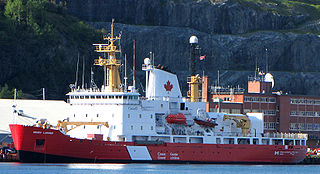
CCGS Henry Larsen is a Canadian Coast Guard Improved Pierre Radisson-class icebreaker serving in the Newfoundland and Labrador region and based in St John's, Newfoundland and Labrador. Entering service in 1988, Henry Larsen is the fourth ship and of an improved design over the rest of the ships in her class. The ship operates in the Arctic Ocean during summer months.

CCGS Amundsen is a Pierre Radisson-class icebreaker and Arctic research vessel operated by the Canadian Coast Guard. The vessel entered service in 1979 as Franklin and was renamed Sir John Franklin in 1980 and served as such until 1996. Declared surplus, the vessel was used as an accommodation ship in Labrador in 1996 and placed in reserve in 2000. In 2003, the ship was reactivated and underwent conversion to an Arctic research vessel. The ship recommissioned as Amundsen.

CCGS Labrador was a Wind-class icebreaker. First commissioned on 8 July 1954 as Her Majesty's Canadian Ship (HMCS) Labrador in the Royal Canadian Navy (RCN), Captain O.C.S. "Long Robbie" Robertson, GM, RCN, in command. She was transferred to the Department of Transport (DOT) on 22 November 1957, and re-designated Canadian Government Ship (CGS) Labrador. She was among the DOT fleet assigned to the nascent Canadian Coast Guard (CCG) when that organization was formed in 1962, and further re-designated Canadian Coast Guard Ship (CCGS) Labrador. Her career marked the beginning of the CCG's icebreaker operations which continue to this day. She extensively charted and documented the then-poorly-known Canadian Arctic, and as HMCS Labrador was the first ship to circumnavigate North America in a single voyage. The ship was taken out of service in 1987 and broken up for scrap in 1989.

CCGS Sir Wilfred Grenfell is a Canadian Coast Guard vessel based in Victoria, British Columbia. Designated an "Offshore Ice Strengthened Multi Patrol Vessel", the former offshore supply vessel is named after the medical missionary in Labrador, Sir Wilfred Grenfell. Constructed in 1984–1985, Sir Wilfred Grenfell was purchased by the Canadian Government and converted for Coast Guard service. In 1994, she played an important role in the fishing conflict known as the Turbot War in the Atlantic Ocean.

CCGS Leonard J. Cowley is an ice-strengthened fisheries patrol vessel of the Canadian Coast Guard. The ship entered service in 1984 and is still currently in service. During the Turbot War, the patrol vessel took part in the detainment of the Spanish fishing vessel Estai. Leonard J. Cowley's home port is St. John's, Newfoundland and Labrador.
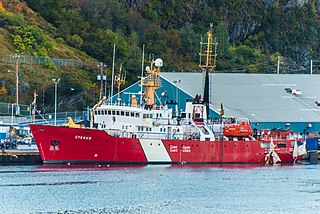
CCGS Cygnus is a Cape Roger-class fisheries patrol vessel of the Canadian Coast Guard. The ship entered service in 1981 and is used to monitor the fisheries along the Atlantic coast of Canada. During the Turbot War, Cygnus was among the Coast Guard vessels sent to monitor the European fishing fleet on the Grand Banks.

CCGS John P. Tully is an offshore oceanographic science vessel in the Canadian Coast Guard operating out of Pacific Region at CGS Base Patricia Bay in Sidney, British Columbia. Prior to 1995, the ship was assigned to Fisheries and Oceans Canada. The vessel entered service in June 1985 with the Department of Fisheries and Oceans on the West Coast of Canada. In 1995, the fleets of Fisheries and Oceans and the Canadian Coast Guard were merged under Canadian Coast Guard command and John P. Tully became a Coast Guard vessel.
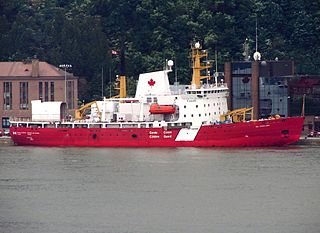
CCGS Des Groseilliers is a Pierre Radisson-class icebreaker in the Canadian Coast Guard. The vessel is named after Médard Chouart des Groseilliers (1618–1669) a close associate of Pierre-Esprit Radisson in explorations west of the Great Lakes and the founding of the British Hudson's Bay Company. The ship entered service in 1982. The vessel has participated in a number of research voyages, including Ice Station SHEBA. As part of the Surface Heat Budget of the Arctic Ocean experiment conducted in the Arctic Ocean from October 1997 to October 1998 to provide polar input to global climate models, Des Groseilliers was allowed to be frozen into the ice for the Arctic winter, to serve as a base for scientific researchers.

CCGS Hudson was an offshore oceanographic and hydrographic survey vessel operated by the Canadian Coast Guard. The ship entered service in 1963 with the Canadian Oceanographic Service, stationed at the Bedford Institute of Oceanography, called CSS Hudson. The ship made several significant scientific voyages, among them the first circumnavigation of the Americas in 1970. The ship was transferred to the Canadian Coast Guard in 1996 and decommissioned in 2022. A replacement is not scheduled for delivery until 2024–2025.
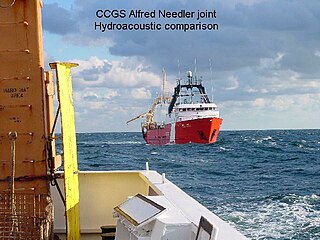
CCGS Alfred Needler is an offshore fishery science vessel formerly operated by the Canadian Coast Guard. The vessel entered service in 1982 with the Department of Fisheries and Oceans, stationed at the Bedford Institute of Oceanography in Dartmouth, Nova Scotia. In 1995, in order to reduce the number of ships and combine tasks, the Fisheries and Oceans fleet and the Canadian Coast Guard fleets were merged under the Canadian Coast Guard. The ship was decommissioned from Canadian Coast Guard service in 2023.

CCGS W.E. Ricker was a Canadian Coast Guard offshore fisheries research vessel. The ship was originally constructed as the commercial fishing trawler Callistratus, but was purchased by the Government of Canada in 1984 and converted to a fisheries research vessel and renamed W.E. Ricker. The vessel entered service with the Department of Fisheries and Oceans in 1986 and was transferred to the Canadian Coast Guard in 1995 after the two fleets were amalgamated. The ship was assigned to the West Coast of Canada and was decommissioned on 14 March 2017.

CCGS N.B. McLean was a Canadian Coast Guard icebreaker. Constructed in 1930 at Halifax Shipyards, she entered service as CGS N.B. MacLean and served in the Department of Transport's Marine Service, using the prefix "Canadian Government Ship". The ship was transferred into the newly created Canadian Coast Guard in 1962. She served in the St. Lawrence River and Gulf of St. Lawrence until she was decommissioned in 1979, and taken to Taiwan to be scrapped in 1989. She was replaced by CCGS Pierre Radisson.

CCGS Tupper was a Canadian Coast Guard ice-strengthened buoy tender that served from 1959 to 1998. The vessel spent her entire career on the East Coast of Canada. Following her Canadian service, Tupper was sold to private interests with the intention of converting her to a yacht, but the conversion never happened and the vessel moved about Halifax Harbour, suffering a fire in 2008 before being sold for scrap in 2011. The vessel was not scrapped and the Canadian Coast Guard was forced to address the pollution concerns of the abandoned vessel in 2021.
CCGS Wilfred Templeman was a Canadian Coast Guard fisheries research vessel that entered service 1981 with the Department of Fisheries and Oceans. In 1995 the Fisheries and Oceans and Canadian Coast Guard fleets were amalgamated and Wilfred Templeman joined the Canadian Coast Guard. The research vessel patrolled the coast off Newfoundland and Labrador. In 2011, the vessel was taken out of service, sold to commercial interests and renamed Blain M.
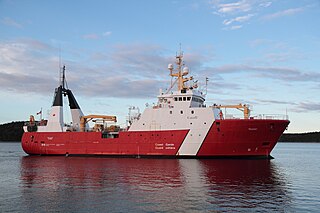
CCGS Teleost is a Canadian Coast Guard fisheries research vessel. The ship was originally constructed in Norway in 1988 as a commercial fishing trawler named Atlantic Champion. In 1993, the Canadian government purchased the vessel and after a competition among schoolchildren, the vessel was named Teleost by the winner. The vessel was converted to an offshore fisheries research vessel in 1994–1995 and entered service in 1996 with the Canadian Coast Guard. The ship is currently in active service.

CCGS George R. Pearkes is a Martha L. Black-class light icebreaker and buoy support vessel in the Canadian Coast Guard. Named for Victoria Cross-winner George Pearkes, the ship entered service in 1986. Initially assigned to Pacific region, the vessel transferred to the Quebec region. George R. Pearkes was assigned to her current deployment, the Newfoundland and Labrador region in 2004.
CCGS Simon Fraser was a buoy tender operated by the Canadian Coast Guard. The vessel entered service in 1960 with the Department of Transport's Marine Fleet, before being transferred to the newly formed Canadian Coast Guard in 1962. The buoy tender served on both coasts of Canada and was used for search and rescue duties along the West Coast of Canada. The ship was loaned to the Royal Canadian Mounted Police in 2000 and transited the Northwest Passage, circumnavigating North America in the process. The ship was taken out of service in 2001 and sold to private interests. In 2006, the vessel reappeared as a yacht using the same name.

CCGS Kopit Hopson 1752, formerly CCGS Edward Cornwallis, is a Martha L. Black-class icebreaker of the Canadian Coast Guard. She serves as a light icebreaker and buoy tender on the East Coast of Canada. Entering service in 1986, the vessel is homeported at Dartmouth, Nova Scotia. The vessel was originally named after Lieutenant General Edward Cornwallis, a British Army officer and founding governor of Halifax, Nova Scotia. Due to the controversial history of the vessel's initial namesake, the ship was renamed in consultation with indigenous peoples, to commemorate Jean-Baptiste Cope under his Mi'kmaq name, British Governor Peregrine Hopson, and the year of the peace and friendship treaty created by former Governor Edward Cornwallis.
CCGS J.E. Bernier was a Canadian Coast Guard medium Arctic icebreaker with a steel hull. The vessel was in service from 1967 to 2006. The ship was initially based at Quebec City but finished her career at St. John's. The ship was named for Joseph-Elzéar Bernier, captain of CGS Arctic which explored and monitored the eastern Arctic for the Government of Canada in the early 20th century. The vessel was sold in 2006 to private interests.

The Pierre Radisson-class icebreakers, also known as R-class icebreakers, are a class of four icebreakers constructed for and operated by the Canadian Coast Guard. The Canadian Coast Guard designates the four ships in the class as medium icebreakers. Built in two phases, the first three ships, Pierre Radisson, Franklin and Des Groseilliers, were built to a common design. The fourth, Henry Larsen was built to a modified design and is considered a subclass, the Improved R-class icebreaker. Franklin was later renamed Sir John Franklin before undergoing a re-design for use primarily as an Arctic research vessel. Upon the vessel's return to service, the ship was once again renamed Amundsen. All the vessels are named for people who sailed through Canada's northern waters. The class operates in the Arctic Ocean in the summer, patrolling, icebreaking and research missions.















